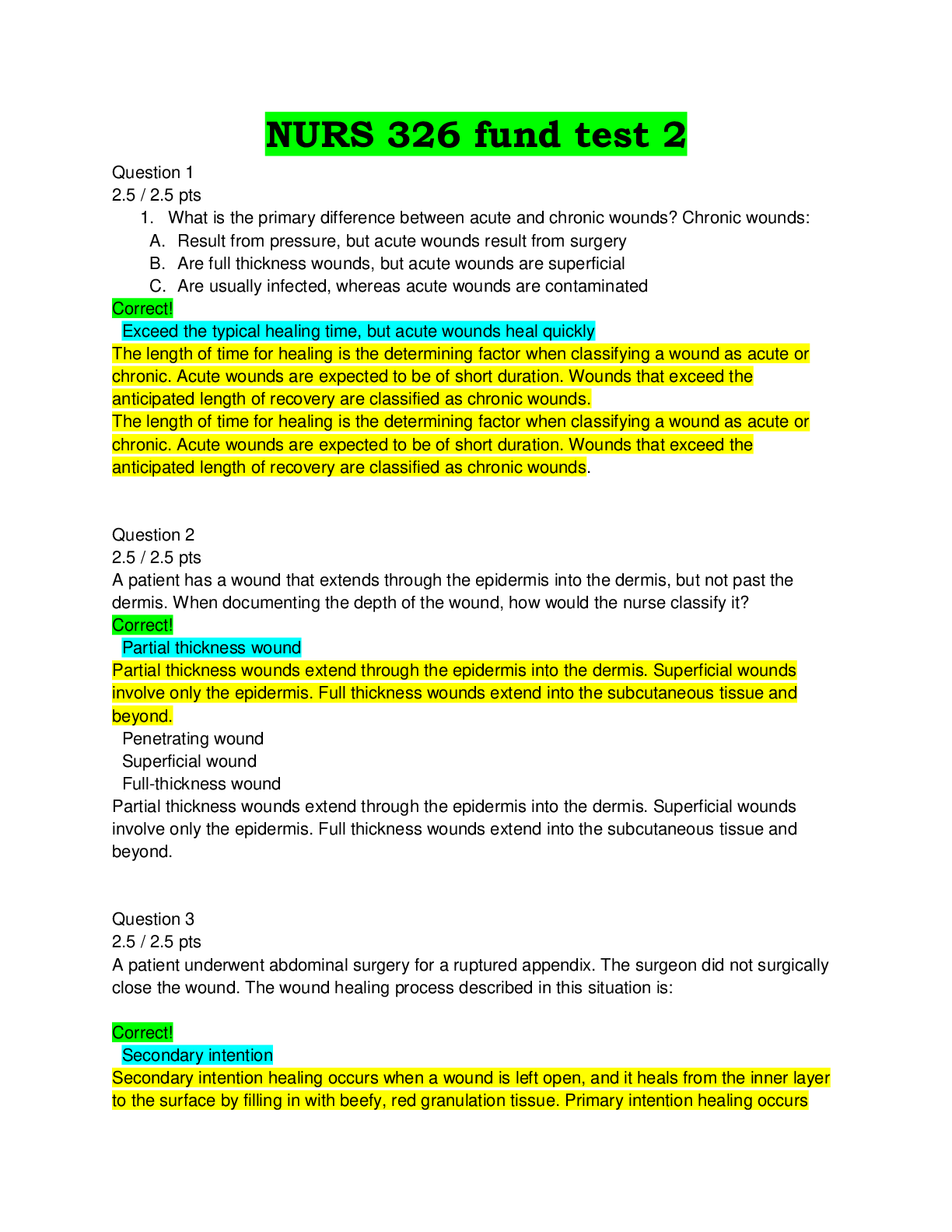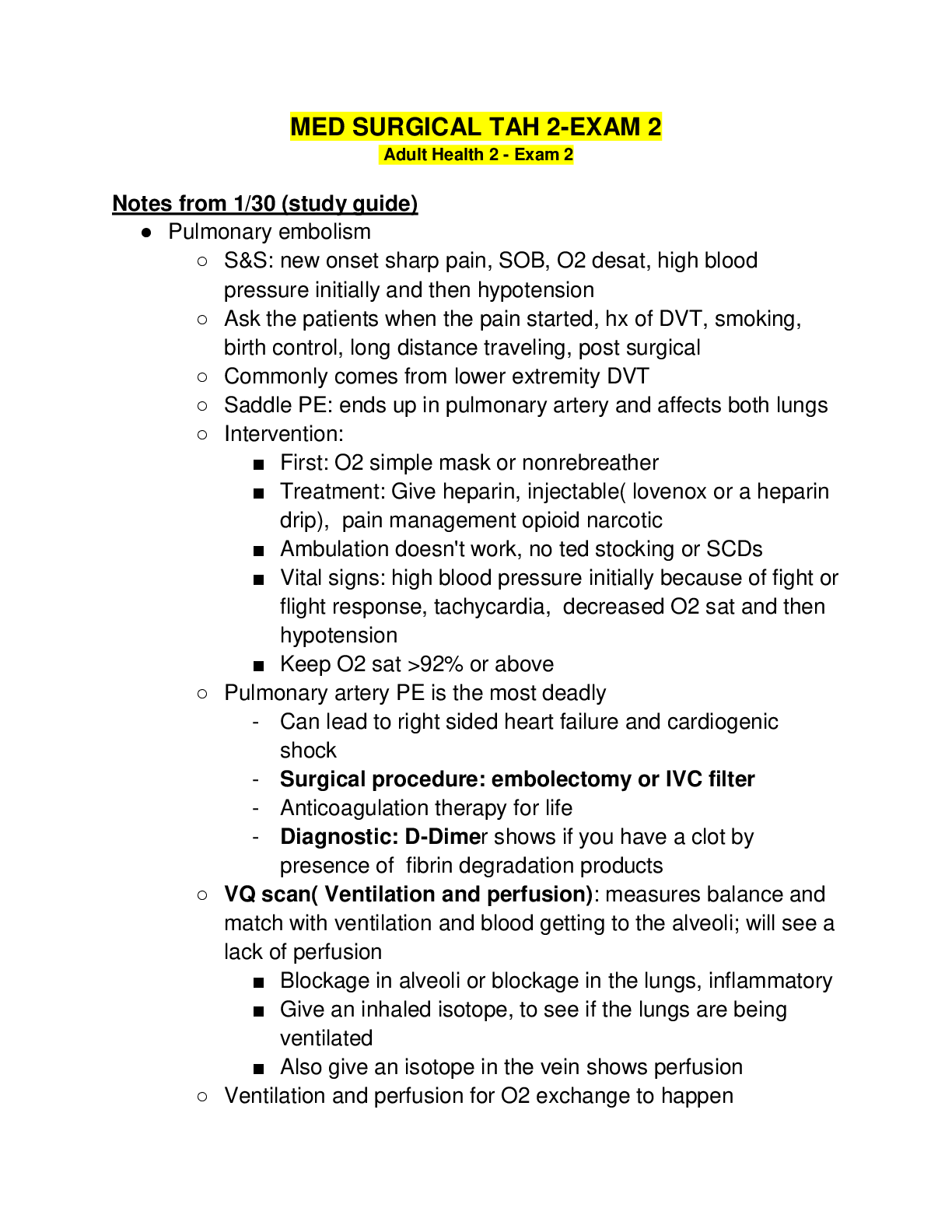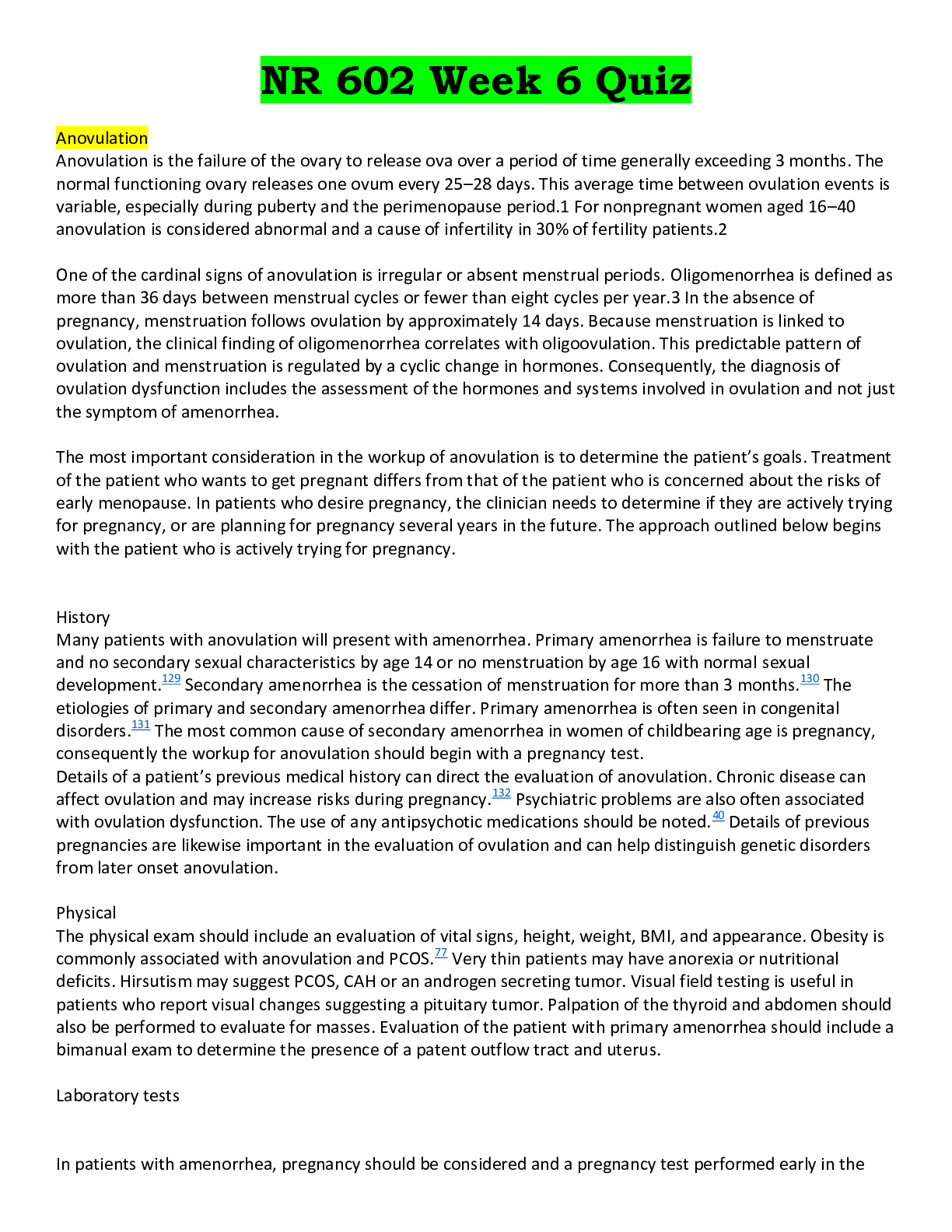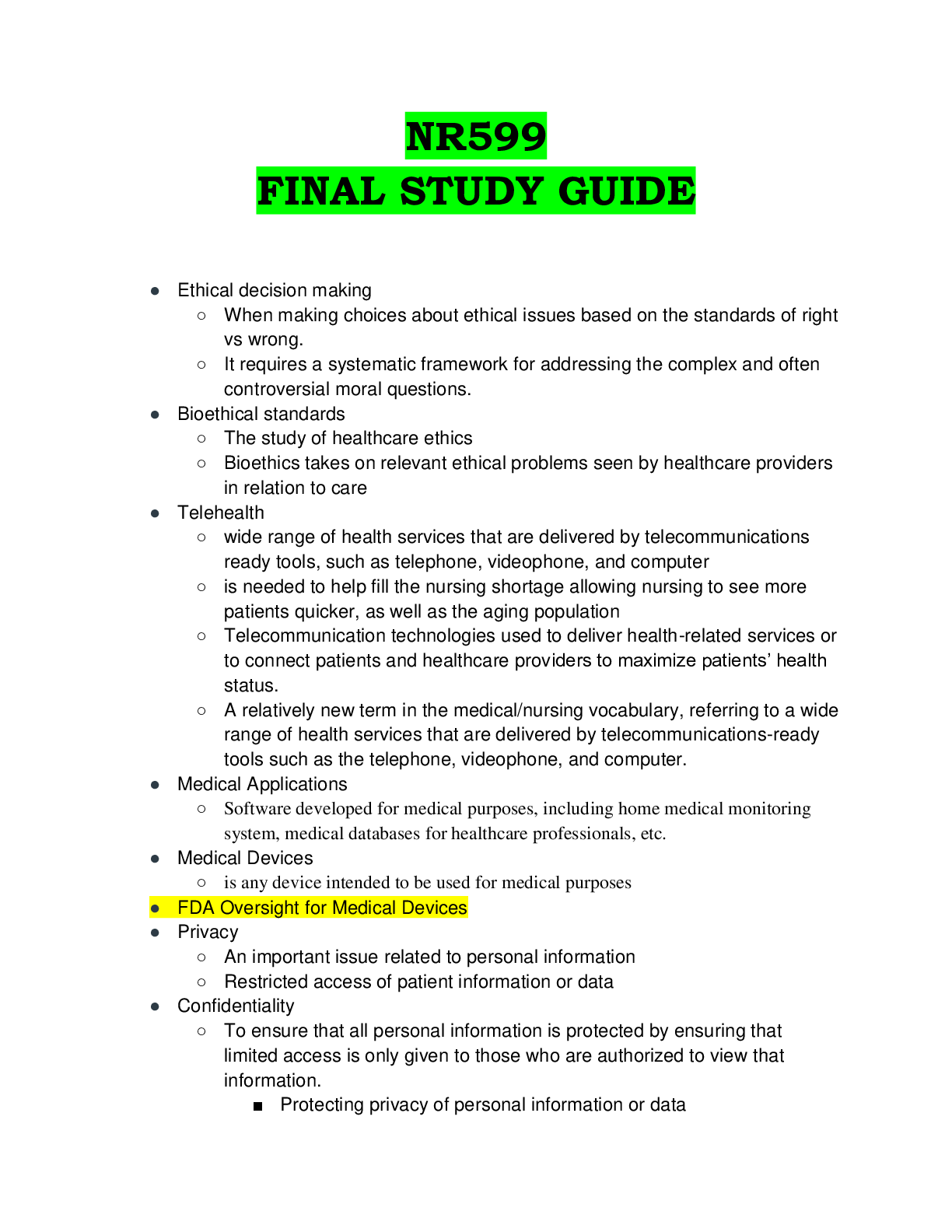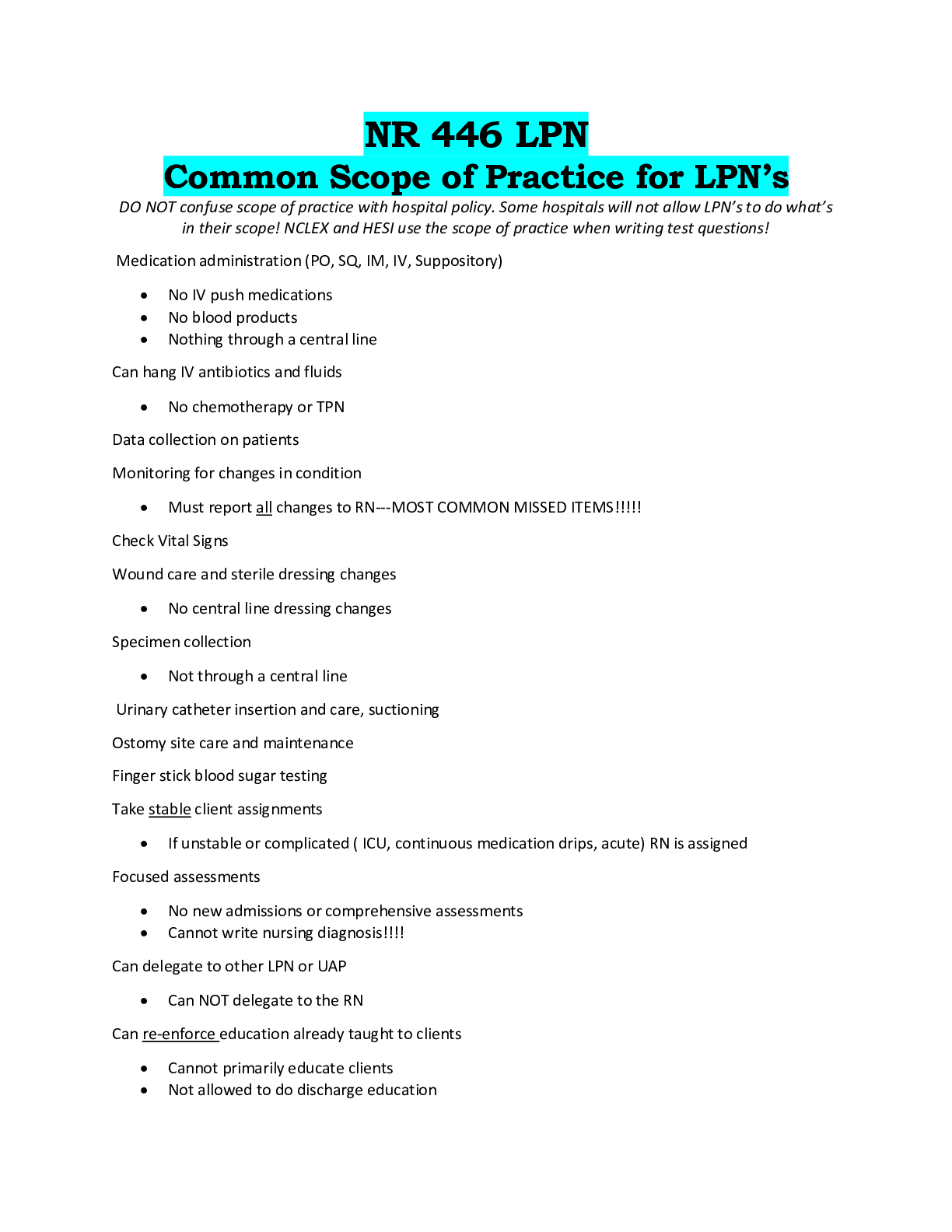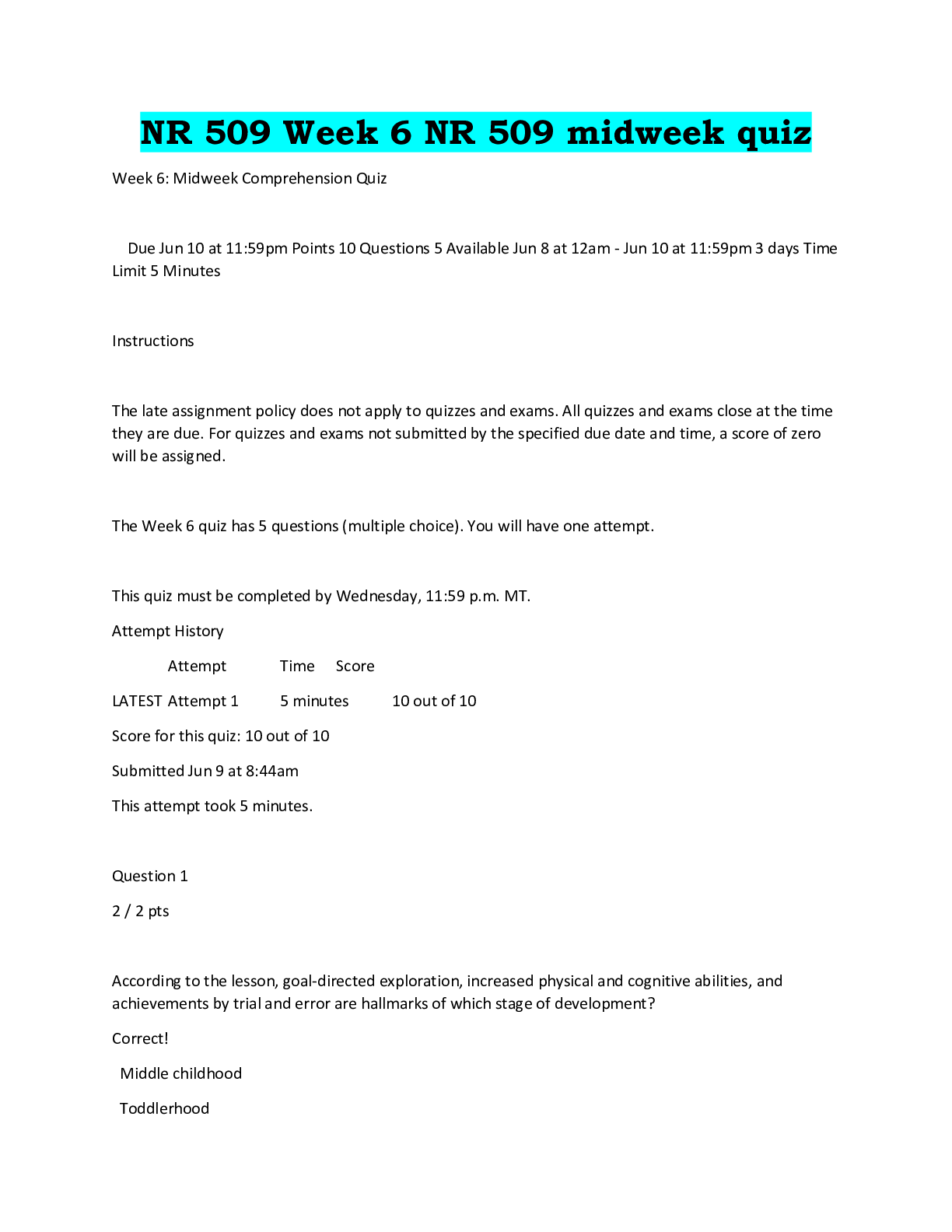*NURSING > EXAM REVIEW > Jeannine’s Math Packet (REVISED) (All)
Jeannine’s Math Packet (REVISED)
Document Content and Description Below
1 Jeannine’s Math Packet (REVISED)2 Table of Contents A. Dimensional analysis (pages 2 – 5) 1. Definition 2. Steps of dimensional analysis 3. One-factor, two-factor and three factor proble... ms 4. Common mistakes students make on exams 5. Example without distractors 6. Example with distractors 7. Solving for “dose VERSUS day” B. General math information (pages 6 – 7) 1. Conversion factors to memorize 2. Error-prone abbreviations that should never be used 3. Error-prone dose designations and “other” information C. Course specific information (pages 8 – 9) 1. Medication administration math independent study modules 2. What is a safe dose calculation? D. Practice math problems (pages 10 – 15) 1. 35 problems 2. Answer key3 A. Dimensional Analysis 1. Definition: “The use of a simple technique with a fancy name for the process of manipulating units. By manipulating units you are able to eliminate or cancel unwanted units”. (Calculating with Confidence, by Deborah Gray Morris, 2010). 2. Steps of dimensional analysis a. Start your problem to the RIGHT of the “equal sign”- what are you solving for?? What is your destination? (mL/hour, mcg/kg/min, tabs, etc…..) b. Plug in the given information (avoiding any distractors) Set-up your train tracks to arrive at your destination c. Cancel out “like units” d. Add conversion factors, as needed Keep adding train tracks until you arrive at your destination 3. When setting up a problem, your “given” information will either be: a. One factor: tablets, milliliters, pounds, kilograms Since dimensional analysis is a manipulation of factors, YOU MUST DECIDE whether your one factor (eg. Pounds), sits in the numerator or denominator of your problem. b. Two factors: mL/hour, gtt/ min, mg/mL YOU MUST DECIDE where your 2 factors are placed (eg. mg / mL). Which label sits in the numerator and which one sits in the denominator of your problem? c. Three factors: mcg/kg/min, units/kg/hour With three factors (Eg. mcg/kg/min), there is NO CHOICE. The first label (mcg) sits in the numerator and the last 2 factors (kg/min) sits in the denominator4 4. Common mistakes students make on math exams a. Not using dimensional analysis (ONE LONG “train track”) and trying to solve the problem in multiple “sub-steps” Example: converting pounds to kilograms separately. 120 pounds x 1 kg = 54.545454 (per calculator) 2.2 pounds If you round this number to 54.5, you might NOT get the correct FINAL answer b. Calculator errors Always multiply the entire numerator across TWICE and write down the answer Always multiply the entire denominator across TWICE and write down the answer Divide these results TWICE to get the final answer You have now made SIX calculator checks!!! c. Bringing the wrong information into the problem: Example: 1000 mL of LR is to infuse over 8 hours 100 mL 8 hour Student accidentally inputs 100 mL instead of 1000 mL d. NOT READING THE INSTRUCTIONS provided at the beginning of the math exam The following is the ACTUAL instructions that will appear on each of your remaining math exams This test is to be completed the first day of lecture. You will have 50 minutes to complete the test. Answers are to be rounded off to the hundredth (two decimal places), except for “ gtt/min” which is rounded to the nearest whole number. Place “final answer” to be graded on the line provided (only ONE answer) Amounts less than one REQUIRE a leading zero ( Eg. 0.5, NOT .5) NEVER place a trailing zero after an answer. If the calculator states “10.8”, then that is your final answer- NOT “10.80” to create a “hundredth place”. Students will not receive credit if work is not shown5 5. Example without distractors Mr. McCormick is receiving dopamine at 15 mL/hr by IV pump. The patient weighs 120 pounds. The dopamine concentration is 250 mg in 250 mL of D5W. Calculate the micrograms per kilogram per minute? Round your answer to the nearest hundredth: STEP ONE: Start to the right of the EQUAL sign (what is your destination?) = mcg kg/min STEP TWO: Plug in the given information (no distractors here) 15 mL X 250 mg = mcg hr 120 lb 250 mL kg/min STEP THREE: Cancel out like units 15 mL X 250 mg = mcg hr 120 lb 250 mL kg/min STEP FOUR: Add conversion factors until you arrive at your destination 15 mL X 250 mg 2.2 lb 1 hr 1000 mcg = 4.58 * mcg hr 120 lb 250 mL 1 kg 60 min 1 mg kg/min *To avoid calculator errors, always check you work, as discussed on the previous page. In the example above, include the following: = 8,250,000 = 4.583 , rounded to 4.58 1.800,0006 6. Example with distractors A 20 kilogram child is being treated for a severe infection. Zosyn IVPB 20 milligrams in 250 mL of LR is ordered and to be infused over 30 minutes. How fast will the nurse set the infusion pump? STEP ONE: Start to the right of the EQUAL sign (what is your destination?) = mL Hr STEP TWO: Plug in the given information QUESTIONS: Are there any distractors “plugged in” below? Which is correct- (A) or (B)? (A) 20 kg * 250 mL x = mL 200 mg * 30 min hr (B) 250 mL = mL 30 min hr *In (A) above, the kg and the mg will never cancel out to arrive at your destination of “mL/hr” !!! STEP THREE: Cancel out like units (NONE to cancel out in this example) 250 mL = mL 30 min hr STEP FOUR: Add conversion factors until you arrive at your destination 250 mL 60 min___ = 15,000 = 500 mL 30 min 1 hour 30 hr7 7. Solving for “day” versus “dose: when does the “frequency” of the medication become part of the problem ? a. You must remember that the physician writes an order as follows: Eg. Acetaminophen 10 mg/kg, PO, every 6 hours The 10 mg/kg is a single dose The route is PO The frequency is every 6 hours b. Example where “frequency of the medication” is a distractor Acetaminophen 10 mg/kg, PO, every 6 hours is ordered for a 5 kg infant. Available is acetaminophen 160 mg/5mL. How many milliliters should the RN prepare for this dose? STEP ONE: Start to the right of the EQUAL sign (what is your destination?) = mL dose STEP TWO: Plug in the given information (add the word “dose” to the train track) 10 mg 5 kg 5 mL = mL Kg/dose 160 mg dose STEP THREE: Cancel out like units 10 mg 5 kg 5 mL = mL Kg/dose 160 mg dose STEP FOUR: NO conversion factors needed- you have arrived at your destination! 10 mg 5 kg 5 mL = 1.56 mL Kg/dose 160 mg dose Note: the original problem states “every 6 hours”. Consider it a distractor when the same word “dose” or “day” appear on BOTH SIDES OF THE EQUAL SIGN.8 c. Example where “frequency of the medication” is part of the problem Acetaminophen 10 mg/kg, PO, every 6 hours is ordered for a 5 kg infant. Available is acetaminophen 160 mg/5mL. How many milliliters should the RN give for the day? STEP ONE: Start to the right of the EQUAL sign (what is your destination?) = mL DAY STEP TWO: Plug in the given information (add the word “dose” to the train track) REMEMBER: physician always orders a single dose! 10 mg 5 kg 5 mL = mL Kg/dose 160 mg DAY STEP THREE: Cancel out like units 10 mg 5 kg 5 mL = mL Kg/dose 160 mg DAY STEP FOUR: Add conversion factors to arrive at destination: 10 mg 5 kg 5 mL 4 doses = 6.25 mL Kg/dose 160 mg DAY DAY Note: the original problem states “every 6 hours”, or 4 doses in a day. It is NOT a distractor when the when one side of equal sign says “day” and one side says “dose” (see STEP 2 above)9 General Math Information 1. Conversion Factors 1 kilogram (kg)=1000grams (g) 1 kilogram (kg)=2.2pounds (lbs) 1 gram (1g)=1000 milligrams (mg) 1 milligram (mg)=1000 microgram (mcg) 1 liter (L)=1000 milliliters (mL) 1 teaspoon (tsp)=5 milliliters (mL) 2. Acceptable Abbreviations * ac = before meals BID = twice a day IM = intramuscular IV = intravenously NG = nasogastric NPO = nothing by mouth pc = after meals PO = per mouth qh = every hour QID = four times a day SL = sublingual Stat = immediately Subcut = subcutaneously TID = three times a day *Pharmacology and the nursing process. By Lilley, Rainforth, Collins and Synder- 2014.10 3. Error-prone abbreviations that should NEVER be used * QD Instead, write “daily” QOD Instead, write “every other day” IU or U Instead, write “units” D/C Instead, write “discontinue” SQ or subQ Instead, write “subcut” cc Instead, write “mL” *http://www.ismp.org/Tools/errorproneabbreviations.pdf. This file is on the Institute for Safe medicine practice website. 4. Error-prone dose designations and “other information * Mistake Intended meaning Misinterpretation Correction Trailing zeros after decimal point Eg. 1.0 mg 1 mg Could be mistaken for 10 mg Never add a zero for a dose expressed as a whole number “Naked” decimal point Eg. .5mg 0.5 mg Could be mistaken for 5 mg if decimal not seen Always add a LEADING zero *http://www.ismp.org/Tools/errorproneabbreviations.pdf. This file is on the Institute for Safe medicine practice website.11 B. Course specific information 1. Medication administration independent math study modules a. Should be posted on each course shell b. States the content of the math exam c. For NR 320, 321, 322, 340, 442, 446, and 452: - Content of each exam is identical: Total of 20 word questions worth 1 point each 95% correct Approximately 2-4 oral, 2-4 injections, 2-4 simple IV, 4-7 simple IV with medications, 6-10 complex IV- some weight-based, 1 – 2 safe dose 2. What is a “safe dose” calculation? a. “Before administering medications to children, the nurse should know whether the ordered dosage is safe. Accuracy is always important when calculating medication dosages. For infants and children, exact and careful mathematics takes on even greater importance. A miscalculation, even small discrepancies, may be dangerous because of the size, weight, and body surface area (BSA) of the infant or child”. (Calculating with Confidence, by Deborah Gray Morris, 2010). b. Where does the nurse find the safe dosage range? “This information comes from a reputable resource, such as a medication reference written especially for pediatrics or another medication reference book- ie. Drug book. Recommended dosages may also be indicated on the medication label under children's dosages. This is usually expressed in mg/kg for a 24-hour period to be given in one or more divided doses.” (Calculating with Confidence, by Deborah Gray Morris, 2010). Example: 10 – 20 mg/kg/day in three divided doses c. Deciding if the dosage ordered by the physician is safe? Example: The primary healthcare provided prescribes Amoxicillin 500 mg PO q 8 hours. The child weighs 70 pounds. The safe dose range is 20 – 40 mg/kg/day in 3 divided doses. Is the dose ordered by the physician safe? A. Amoxicillin 500 mg PO q 8 hours (ordered dose by the doctor) B. 20 - 40 mg/kg/day in 3 divided doses ( safe dose range ) d. Let’s do the math on the next page!12 The primary healthcare provided prescribes Amoxicillin 500 mg PO q 8 hours. The child weighs 70 pounds. The safe dose range is 20 – 40 mg/kg/day in 3 divided doses. Round answer to nearest hundredth. (a) What is the minimum safe dose in mg/dose? 20 mg 70 lb 1 kg DAY = 1,400 = 121.121 = 121.12 mg/dose Kg/day 2.2 lb 3 doses 6.6 (b) What is the maximum safe dose in mg/dose? 40 mg 70 lb 1 kg DAY = 2,800 = 424.242 = 424.24 mg/dose Kg/day 2.2 lb 3 doses 6.6 (c) Is the dose ordered by the physician safe? (dose highlighted in RED above)- 500 mg As stated in (a) above, the MINIMUM safe dose to administer is 121.12 mg/dose As stated in (b) above, the MAXIMUM safe dose to administer is 424.24 mg/dose Since the ordered dose of 500 mg is NOT “in between” the minimum and maximum safe doses- it is NOT safe to administer. The RN must call the physician to clarify the orders!13 C. Practice Problems- NOTE: Use these math problems to prepare for every math test for the remainder of the program. Questions on each course exam will focus on the specific patient population and type of medications administered to that population- BUT the “style” of the questioning will be the same! Following the rounding rules discussed earlier in Section A, number 4 Solving for: Tabs/dose mL/dose mL/dose (weight-based) 1. A client is receiving alprazolam (Xanax) 0.75 mg PO BID for anxiety. Alprazolam is available in 0.5 mg scored tablets. How many tablets per dose will the RN administer? 2. A child with a urinary tract infection is receiving Cephalexin (Keflex) 100 mg suspension PO QID. Keflex oral suspension is labeled 125 mg in 5 mL. How many milliliters per dose will the RN administer? 3. A child weighing 28.4 kg is in a hypertensive crisis. The healthcare provider prescribes methyldopa (Aldomet) 40 mg/kg/day in 4 divided doses. The pharmacy provides a 50 mg/mL vial. How many milliliters per dose will the RN administer? Solving for SIMPLE IV (with and w/o meds): - remember, there might be distractors mL/hour gtt/min 4. The nurse is preparing to administer Vancomycin 750 mg in 250 mL of D5W, and plans to administer the dose over 75 minutes. The secondary infusion pump should be programmed to administer how many mL/hour? 5. The healthcare provided prescribes a continuous infusion of 5% dextrose in 45% sodium chloride at 85 mL/hour. The IV administration set delivers 10 gtt/mL. The RN should regulate the drop rate to deliver how many gtt/minute? 6. The healthcare provider prescribes a continuous intravenous infusion of one liter of lactated ringers to infuse over 8 hours. The nurse should program the infusion pump to deliver how many mL/hour? 7. The physician has prescribed Cefoxitin 2 grams IVPB every 6 hours to dissolve in 50 mL and infuse over 30 minutes. The drop factor is 15 gtt/mL. Calculate the flow rate in gtt/min.14 8. Your patient is going to receive 2 grams of magnesium sulfate in 500 mL of 0.9% normal saline to infuse over 30 minutes. How many mL/hour will you set the infusion pump to infuse? Solving for COMPLEX IV (with and w/o meds): mL/hour mg/min mg/hour mU/min mcg/kg/min units/kg/hour 9. A client is experiencing cardiogenic shock receives a prescription for an IV of 0.9% normal saline with milrinone (Primacor) 10 mg in 100 mL at a rate of 46 mcg/minute. The nurse should program the infusion pump to deliver how many mL/hour? 10. A client who had a mitral valve replacement surgery receives a prescription for dextrose 5% in water with 0.5 grams of dobutamine in 250 mL for IV infusion at a rate of 5 mcg/kg/minute. The client weighs 75 kg. The nurse should program the infusion pump to deliver how many mL/hour? 11. Inocor 0.1 grams in 100 mL of normal saline is prescribed for a client with heart failure. The medication is to be delivered at a rate of 400 mcg/minute. The nurse should program the infusion pump to deliver how many mL/hour? 12. A client with septic shock receives a prescription for dextrose 5% in water with dopamine (Intropin) 0.6 grams in 250 mL at a rate of 5 mcg/kg/minute. The client weighs 148 pounds. The nurse should program the pump to deliver how many mL/hour? 13. A client who weighs 176 pounds is receiving an IV infusion with esmolol hydrochloride (Brevibloc) at 48 mL/hour. The IV solution is labeled with the concentration of Brevibloc 10 mg/mL. How many mcg/kg/minute is the client receiving? 14. A client who weighs 70 kg is receiving a dopamine solution of 800 mg in 500 mL of normal saline at 5 mL/hour. How many mcg/kg/minute is the client receiving? 15. An insulin drip is infusing at 15mL/hour for a child who is 30 kg. The insulin is mixed as 50 units in 250 milliliters of 0.9 normal saline. How many units per kilogram per hour is the insulin infusing? 16. A client is receiving an IV solution of sodium chloride 0.9% normal saline 250 mL with amiodarone (Cordarone) 1 gram at 17 mL/hour. How many mg/minute of amiodarone is infusing? 17. An IV infusion of dextrose 5% in normal saline with oxytocin (Pitocin) 20 units in 1,000 mL is prescribed for a client to control postpartum bleeding. The solution is to be administered at a rate of 2mU/minute. NOTE: 1,000 mU = one unit. How many mL/hour is the client receiving? 18. The nurse notes that a client is receiving an oxytocin (Pitocin) infusion via pump that is programmed to delivery 30 mL/hour. The available solution is Lactated Ringer’s 1,000 mL with 20 units Pitocin. How many mU/minute is the client receiving? NOTE: 1,000 mU = one unit.15 19. A client with hypertension who weighs 60 kg is receiving an infusion of nitroprusside (Nipride) 50 mg in D5W 250 mL at 75 mL/hour. How many mcg/kg/minute is the client receiving? 20. A client is receiving an IV solution of 2 grams of medication diluted in 100 mL of normal saline over a one hour timeframe. How many mg's of medication is the client receiving per minute? 21. The healthcare provider prescribes propofol (Diprivan ) at 8 mcg/kg/minute for a client during conscious sedation. The drug is dispensed as 100 mg/50 mL 0.9% normal saline. The client weighs 198 pounds. The nurse should program the infusion pump to deliver how many mL/hour? 22. A client weighing 86 kg is receiving dopamine at 8 mcg/kg/minute. The drug is dispensed as dopamine 800 mg in 500 mL of normal saline. The nurse should program the infusion pump to deliver how many mL/hour? 23. A client who weighs 68 kg is receiving an infusion of dopamine 300 mg in 250 mL D5W at 16 mL/hour. How many mcg/kg/minute is the patient receiving? 24. The nurse programs an infusion pump of Lactated Ringer’s 1,000 mL with oxytocin (Pitocin) 40 units to deliver 15 mL/hour. How many mU/min is the client receiving? NOTE: 1,000 mU = one unit. 25. A client who has preeclampsia receives a prescription for an IV infusion of 4 grams magnesium sulfate in 250 mL normal saline at a rate of 125 mL/hour. The nurse should administer how many mg/hour of magnesium sulfate? 26. A client scheduled for a stress echocardiogram is to receive an IV infusion of dobutamine 500 mg in 250 mL of dextrose 5% in water at a rate of 1,200 mcg/minute. The nurse should program the infusion pump to deliver how many mL/hour? Safe dose calculations Three-step problem reviewed in Section C, number 2 mg/dose 27. A client is receiving dantrolene sodium (Dantrium) PO for malignant hyperthermia. The maximum safe dose is 8 mg/kg/day in 4 divided doses. The client currently weighs 48.5 kg. What is the maximum safe dose (in mg/dose) the RN should administer? 28. The healthcare provider has prescribed Cardizem PO for an infant who weighs 22 pounds. The maximum safe dose is 3.5 mg/kg/day in 4 divided doses. What is the maximum safe dose (in mg/dose) the RN should administer? 29. The pediatrician orders amoxicillin (Amoxil) 60 mg, PO, TID. The child weighs 12.5 pounds. The safe dose range is 20 – 40 mg/kg/day in three divided doses. Is the ordered prescribed by the physician safe? (a) What is the minimum safe dose in mg/dose? (b) What is the maximum safe dose in mg/dose? (c) Is the prescribed dose safe?16 30. A child has rheumatic fever. The pediatrician has ordered penicillin V potassium 250 mg, PO, q 8 hours. The child weighs 45 pounds. The safe dose range is 25 – 50 mg/kg/day in three divided doses. Is the prescribed dose safe? (a) What is the minimum safe dose in mg/dose? (b) What is the maximum safe dose in mg/dose? (c) Is the prescribed dose safe? 31. A child has been diagnosed with a seizure disorder. The pediatrician has ordered phenobarbital 35 mg, PO, BID. The child weighs 20 pounds. The safe dose range is 5 – 7 mg/kg/day in two divided doses. Is the prescribed dose safe? (a)What is the minimum safe dose in mg/dose? (b)What is the maximum safe dose in mg/dose? (c)Is the prescribed dose safe? 32. A child has a severe systemic infection. The PICU physician has ordered tobramycin (Nebcin) 15 mg, IV, q 6 hours. The child weighs 20 kg. The safe dose range is 6 – 7.5 mg/kg/day in four divided doses. Is the prescribed dose safe? (a) What is the minimum safe dose in mg/dose? (b) What is the maximum safe dose in mg/dose? (c) Is the prescribed dose safe? 33. A child has been diagnosed with a serious fungal infection. The physician has ordered fluconazole (Diflucan) 300 mg, IV, per day, for 10 days. The child weighs 55 pounds. The safe dose range is 6 – 10 mg/kg/day. Is the prescribed dose safe? (a) What is the minimum safe dose in mg/dose? (b) What is the maximum safe dose in mg/dose? (c) Is the prescribed dose safe? 34. A child has been diagnosed with sepsis and is admitted to the pediatric intensive care unit. The physician has ordered Gentamycin 12 mg, IV, q 8 hours in D5W, over 30 minutes. The child weighs 4 kg. The safe dose range is 5 – 7.5 mg/kg/day in three divided doses. Is the prescribed dose safe? (a) What is the minimum safe dose in mg/dose? (b) What is the maximum safe dose in mg/dose? (c) Is the prescribed dose safe? 35. A 50-year old has been diagnosed with a respiratory tract infection. The physician has ordered Ticar 4 grams IV, q 6 hours. The patient weighs 175 pounds. The safe dose range is 200 – 300 mg/kg/day in four divided doses. Is the prescribed dose safe? (a) What is the minimum safe dose in mg/dose? (b) What is the maximum safe dose in mg/dose? (c) Is the prescribed dose safe?17 Solving for COMPLEX IV - additional problems added June 2014 mg/DAY mL/DAY mL/dose mg/dose tablets/DAY 36. The physician has ordered Amoxicillin 20 mg/kg/DAY, PO, in 3 divided doses for a 18 pound infant who has developed an infection. How many milligrams will the infant receive in a day? 37. A physician has ordered Dilantin 150 mg, PO, TID. Available is Dilantin 30 mg/2mL. How many milliliters will the patient receive in a 24 hour period? 38. The physician has ordered amoxicillin 15 mg/kg, every 8 hours, for a patient weighing 55 kg. How many milligrams per dose will the patient receive? 39. An child is receiving Ceclor 40 mg/kg/day in equal doses every 6 hours. The infant weighs 22 pounds. How many milligrams per dose is the child receiving? 40. A physician has ordered diflucan 0.3 grams, PO, BID. Available is 200 mg tablets. How many tablets will the patient take in a 24 hour period? 41. The physician orders morphine 0.06 mg/kg, IVP, every 6 hours for pain. Available is 10mg/5ml. The infant weighs 10 pounds. How many milliliters per dose will the infant receive? 42. Acetaminophen 12 mg/kg, every 6 hours, is ordered for a child weighing 10 kg. The drug is available in a concentration of 160 mg/5mL. How many milliliters per dose will the child receive? 43. Acetaminophen 12 mg/kg, every 6 hours, is ordered for a child weighing 10 kg. The drug is available in a concentration of 160 mg/5mL. How many milliliters per DAY will the child receive? 44. Acetaminophen 12 mg/kg, every 6 hours, is ordered for a child weighing 10 kg. The drug is available in a concentration of 160 mg/5mL. How many milligrams per dose will the child receive? 45. Acetaminophen 12 mg/kg, every 6 hours, is ordered for a child weighing 10 kg. The drug is available in a concentration of 160 mg/5mL. How many milligrams per DAY will the child receive? 46. Dexamethasone 0.4 mg/kg/DAY, IVP, in 3 divided doses is ordered for a patient weighing 25 kg. The medication is available as 4 mg/mL. How many milliliters per dose will the child receive? 47. The physician orders Tagamet 30 mg/kg/DAY in 3 divided doses. The child weighs 40 kg. The drug is supplied as 300 mg/5mL. How many milliliters will the patient receive per day? 48. The physician orders Synthroid 2 mcg/kg/day, PO, BID for a child weighing 50 pounds. Synthroid is available as 0.2 mg/5mL. How many milliliters will be administered for the day? 49. A pediatric client is placed on a maintenance dose of digoxin elixir. The dosage is 0.07 mg/kg/day to be administered twice daily. The client weighs 7.2 kg. How many milligrams of digoxin should the nurse prepare for each dose? 50. Ganstrisin 1 gram, PO, QID, is ordered. Available are 500 mg tablets. How many tablets will the nurse administer in a day?18 ANSWER KEY 1. 1.5 tablets/dose 2. 4 milliliters/dose 3. 5.68 mL/dose 4. 200 mL/hour 5. 14 gtt/minute 6. 125 mL/hour 7. 25 gtt/min 8. 1000 mL/hour 9. 27.6 mL/hour 10. 11.25 mL/hour 11. 24 mL/hour 12. 8.41 mL/hour 13. 100 mcg/kg/min 14. 1.9 mcg/kg/min 15. 0.1 units/kg/hour 16. 1.13 mg/minute 17. 6 mL/hour 18. 10 mU/minute 19. 4.17 mcg/kg/minute 20. 33.33 mg/minute 21. 21.6 mL/hour 22. 25.8 mL/hour 23. 4.71 mcg/kg/min 24. 10 mU/min 25. 2000 mg/hour 26. 36 mL/hour 27. 97 mg/dose 28. 8.75 mg/dose 29. (a) 37.88 mg/dose (b) 75.76 mg/dose (c) yes, the 60 mg prescribed is “between” 37.88 and 75.66 30. (a) 170.45 mg/dose (b) 340.91 mg/dose (c) yes, the 250 mg prescribed is “between” 170.45 and 340.9119 31. (a) 22.73 mg/dose (b) 31.82mg/dose (c) No, the 35 mg prescribed is NOT “between” 22.73 mg and 31.82 mg 32. (a) 30 mg/dose (b) 37.5 mg/dose (c) No, the 15 mg prescribed is NOT “between” 30 mg and 37.5 mg 33. (a) 150 mg/dose (b) 250 mg/dose (c) No, the 300 mg prescribed is NOT “between” 150 mg and 250mg 34. (a) 6.67 mg/dose (b) 10mg/dose (c) NO, 12 mg prescribed is NOT “between” 6.67 mg and 10 mg 35. (a) 3,977.27 mg/dose (b) 5,965.91 mg/dose (c) YES, 4 grams (4,000 mg) prescribed is “between” 3,977.27 mg and 5,965.91 mg 36. 163.64 mg/DAY 37. 30 mL/DAY 38. 825 mg/dose 39. 100 mg/dose 40. 3 tablets/DAY 41. 0.14 mL/dose 42. 3.75 mL/dose 43. 15 mL/DAY 44. 120 mg/dose 45. 480 mg/DAY 46. 0.83 mL/dose 47. 20 mL/DAY 48. 1.14 mL/DAY 49. 0.25 mg/dose 50. 8 tabs/DAY [Show More]
Last updated: 1 year ago
Preview 1 out of 19 pages
Reviews( 0 )
Document information
Connected school, study & course
About the document
Uploaded On
May 15, 2021
Number of pages
19
Written in
Additional information
This document has been written for:
Uploaded
May 15, 2021
Downloads
0
Views
31


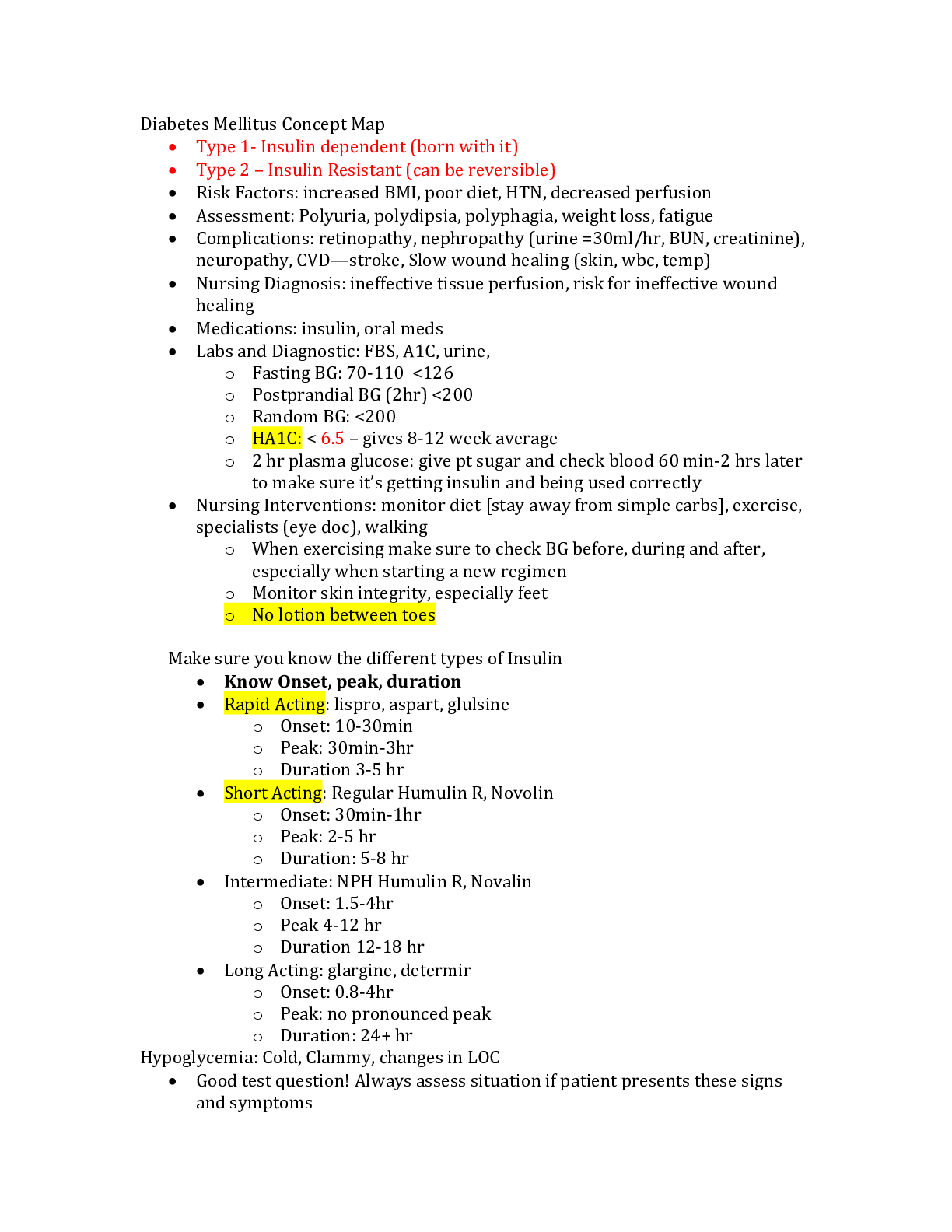
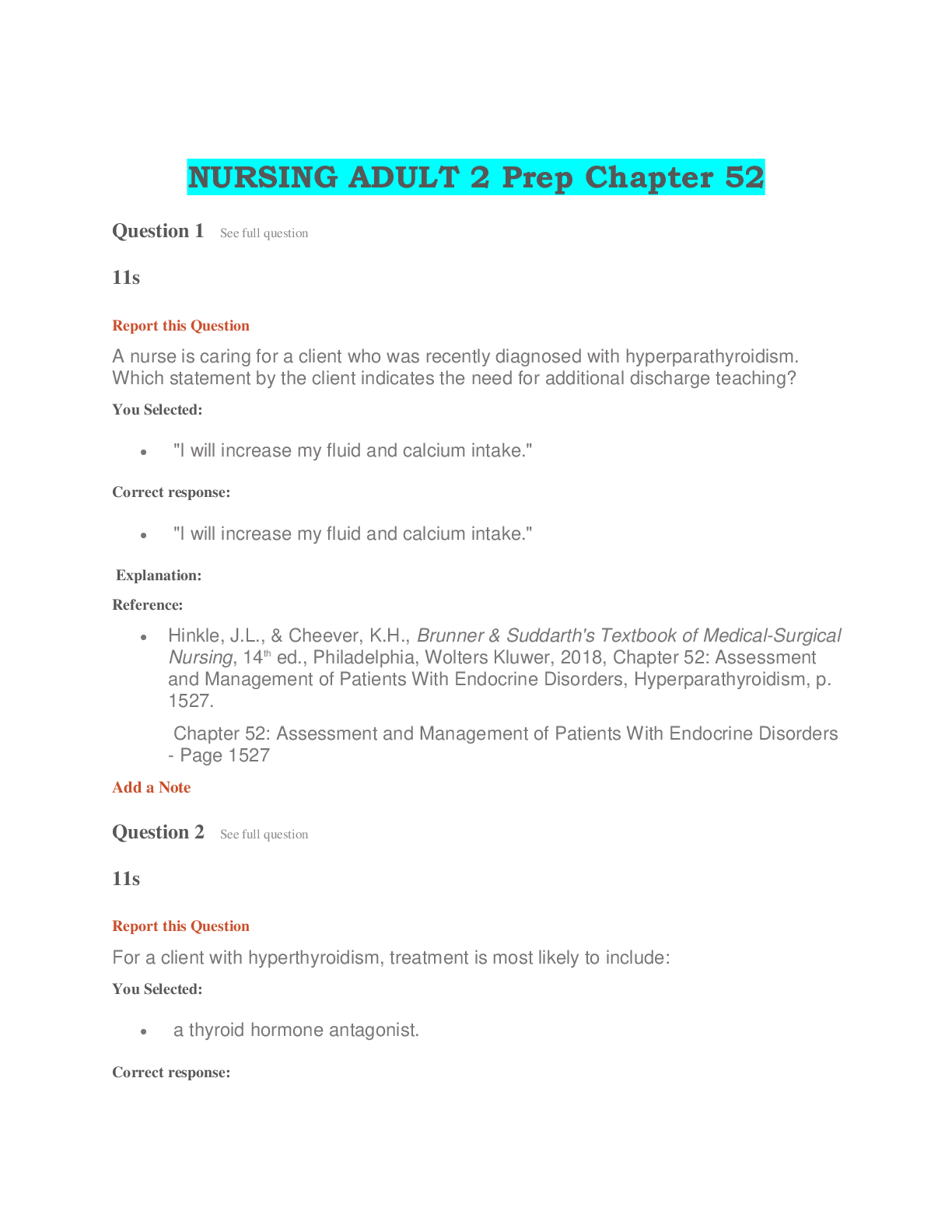
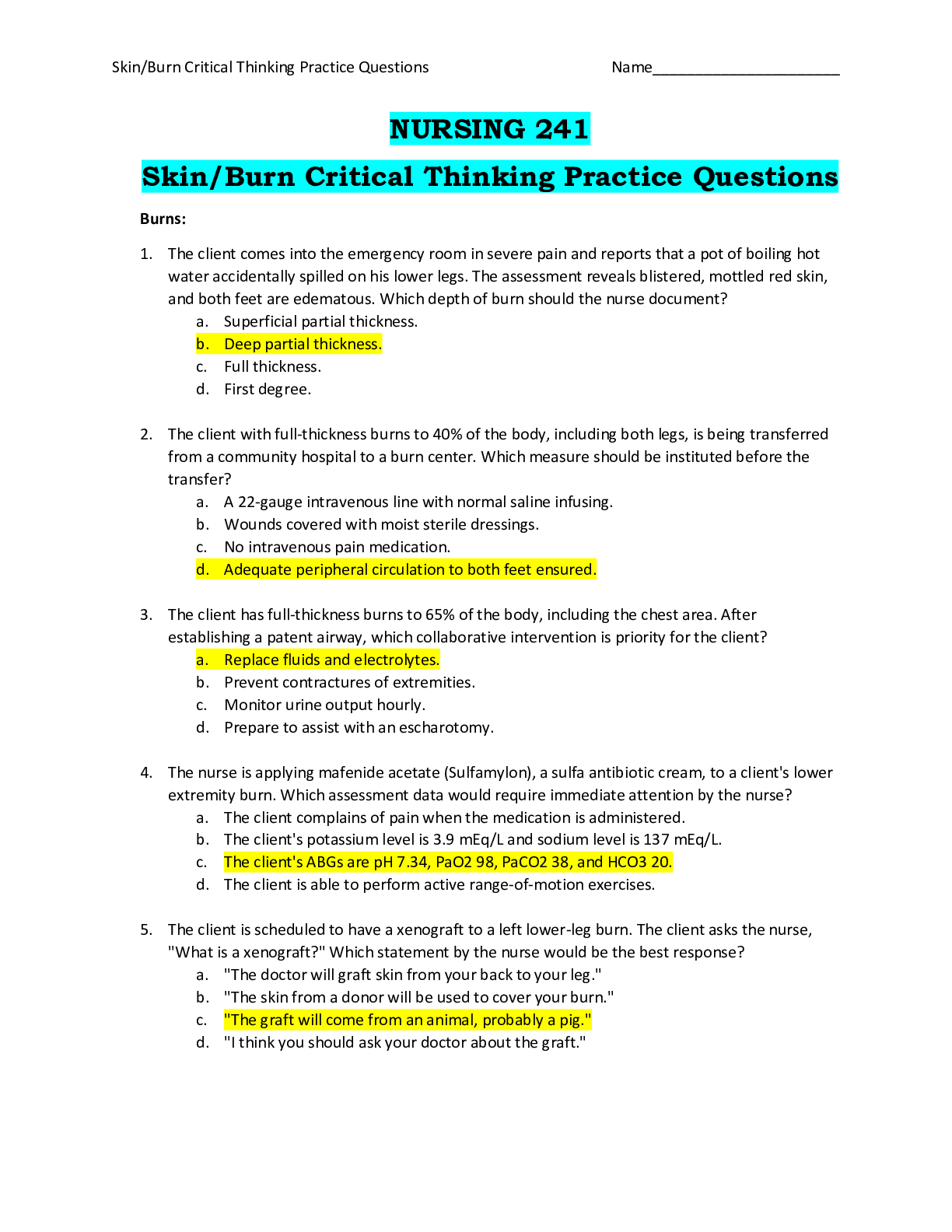
.png)
